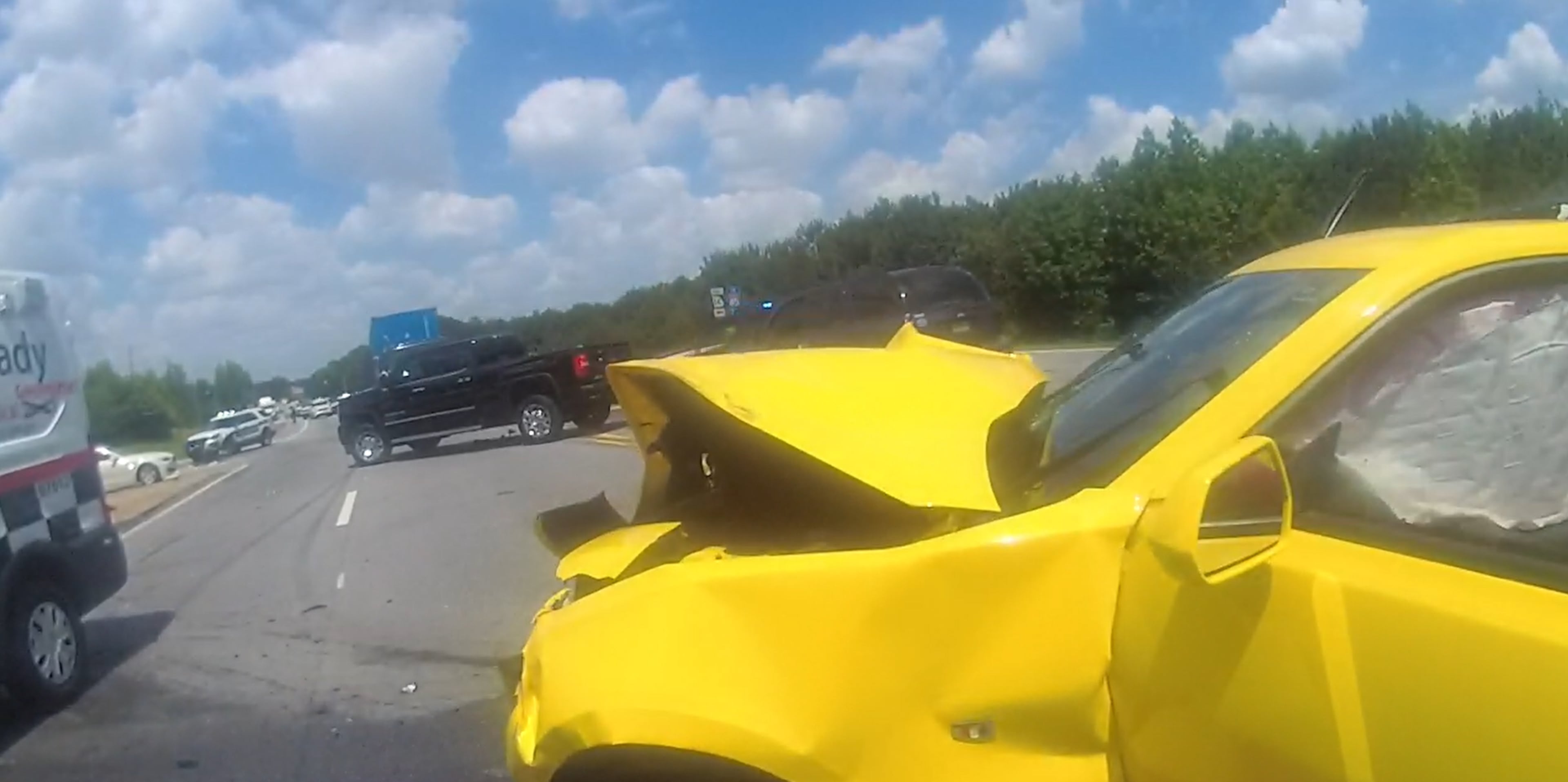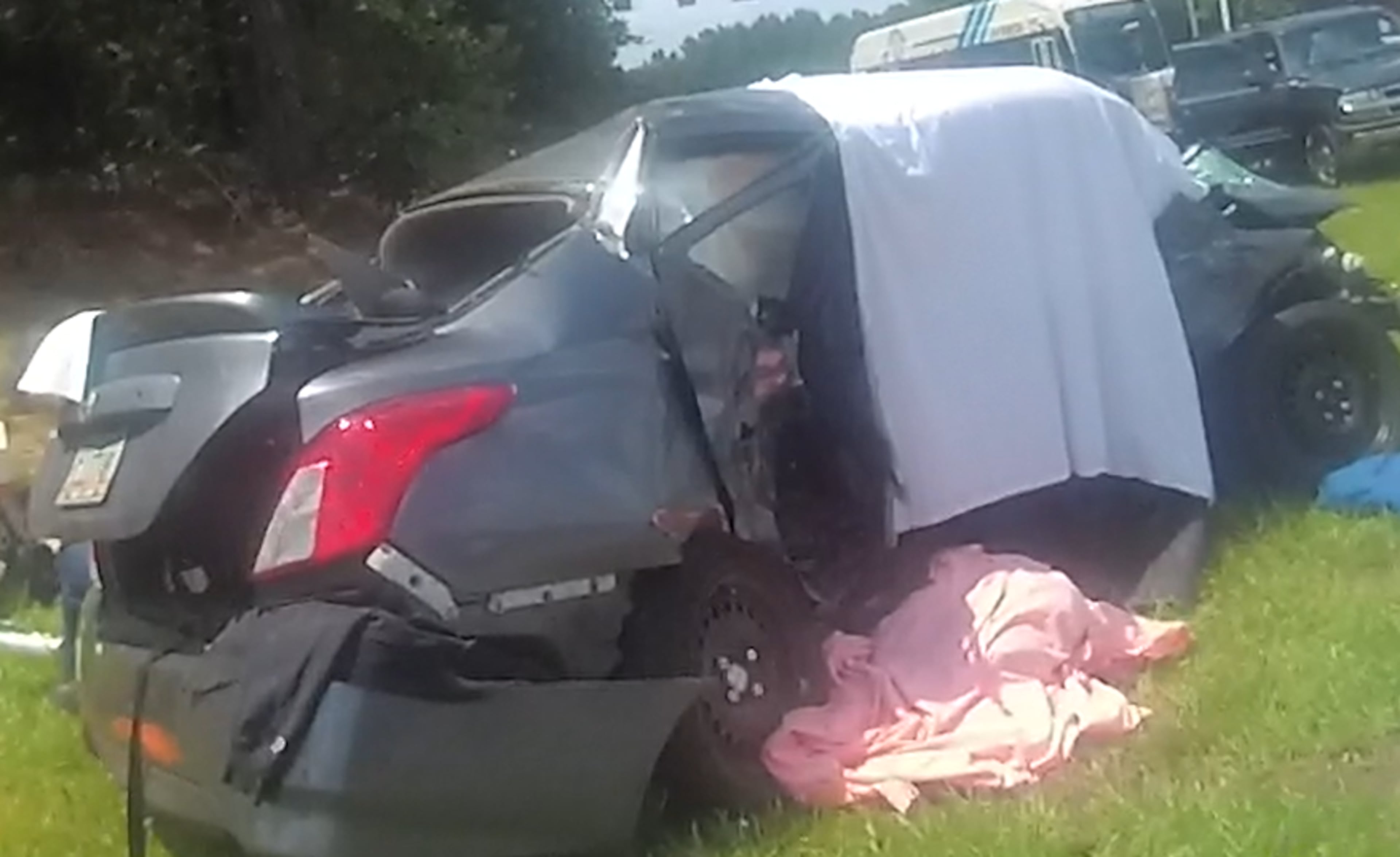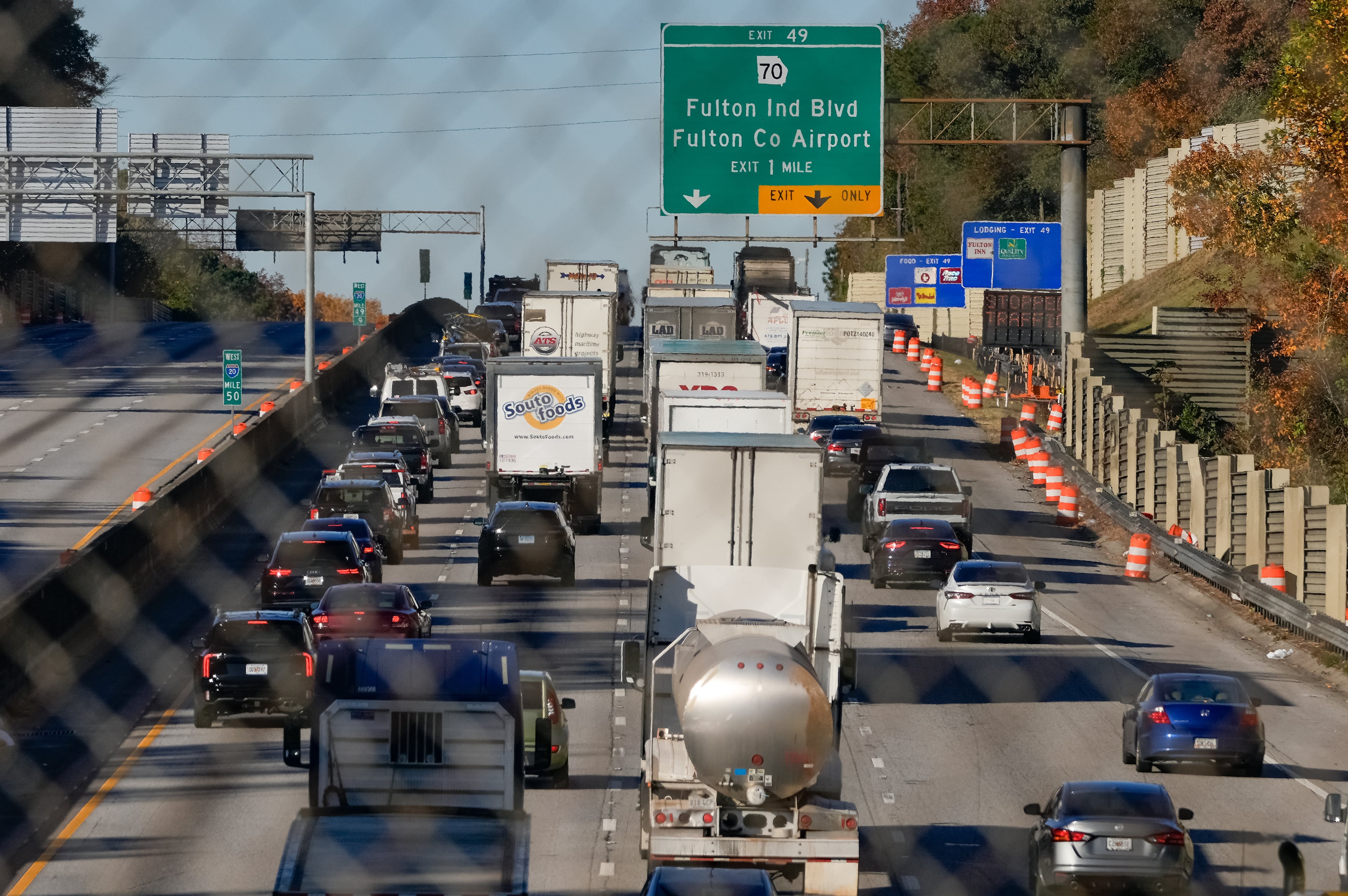A Camaro going 98 mph. Five people killed. One driver still at large.
COLLEGE PARK — Just outside the Perimeter, past the tire shops and the gas stations, Roosevelt Highway curves toward the south and widens from two lanes to four. It becomes an open road, a place where a driver might feel free to press the accelerator.
As she waited to make the last left turn of her life, Sherita Carter may have seen both cars rushing toward her. One was a white Dodge Challenger; the other a yellow Chevrolet Camaro.
At least three witnesses said the same thing: When the Challenger and the Camaro roared down this stretch of Roosevelt Highway on June 2, 2020, it looked as if they were racing.
The ensuing collision received little media attention in the chaos of the pandemic — but it took the lives of five people, including three children.
It horrified a Georgia State Patrol crash investigator so deeply that he stopped investigating crashes.
It led a grand jury to indict the Camaro’s driver for reckless driving and five counts of vehicular homicide — charges that are still pending because the driver has not been arrested.
And as the years passed, survivors wondered when the authorities would find Jerry Devaun Bates and hold him accountable.
“He took my whole family,” said Curt Hollie, 28, who lost his mother, sister, two brothers and a cousin when the Camaro hit their Nissan with devastating force.
‘It looked like a mass shooting’
The smells of a crash scene become familiar to a crash investigator: the gasoline, the brake fluid, the air bags giving off a residue of cornstarch or talcum powder. As a member of the Georgia State Patrol’s Specialized Collision Reconstruction Team, Trooper First Class Shane Pierce had seen many terrible things. But there was something different about what he saw on that hot afternoon on Roosevelt Highway.
“There was bodies and cars everywhere,” he said. “It looked like a mass shooting.”
Pierce knew he had to keep his composure in public. But when he saw a supervisor’s vehicle, he put his head inside through an open window and cried like a little child.
In a motor-vehicle crash, there is one collision after another. Pierce understood this from his training and experience. One car hits another car. Your body hits the inside of the car. And your organs hit the inside of your body. Once he worked a crash in Lawrenceville that involved a woman who was smiling and walking around in the aftermath. But she died before reaching the hospital, Pierce said. Her aorta had pulled away from her heart.

By the time Pierce got to Roosevelt Highway that day in 2020, the white Dodge Challenger was nowhere in sight. A witness said it had been winning the race. It apparently went on unscathed.
The yellow Camaro had broadsided the family’s Nissan. The Camaro’s front end was smashed. Its left taillight was flashing red. The windshield wipers swished uselessly back and forth. The driver’s door was open, and Jerry Devaun Bates lay on the pavement. He was badly injured, but he would survive.
Some time after the crash, Pierce said, he had a brief conversation with Bates. He said Bates was cursing a lot, and said something like, “I can’t believe she did this to my car.”
The gray Nissan Versa had taken on a strange new shape. The windshield had pulled free of the frame, cracked and opaque and pale green, like the surface of a frozen river. All five of the Nissan’s occupants were either dead or dying.

Sherita Carter was in the driver’s seat. She worked at Publix and decorated cakes. She liked to read and had a lovely singing voice. She made very good sandwiches. Carter was wearing her seat belt. She also wore a necklace with a heart-shaped pendant. Her injuries included five broken ribs, lacerations to her spleen and liver, and a brain hemorrhage. She was 43.
Her 19-year-old daughter, Tiara Carter, sat in the front passenger seat. Tiara was considered “the nicest person in the world” by both her older brother and her grandmother. Like her mother, she had a lovely singing voice. She sang in the chorus at Tri-Cities High School in East Point. She liked to order chicken tenders at restaurants, even when her father took her to Red Lobster. She was wearing her seat belt. One of her shoes was missing. The impact had cut her aorta and severed her spinal cord.
Antonio Sinkfield Jr. was in the back seat. He was Sherita’s 10-year-old nephew. Antonio loved his father and enjoyed Takis and Roblox. He played often with his 10-year-old cousin Jaylin Carter, who was also in the back seat. They liked playing tricks on their grandmother. Sometimes they’d come home from school and tell her: “We don’t have homework. We had a substitute today.” Or they’d encourage her to go and rest, because they knew she was tired, and then they’d sneak away to the park. Antonio’s legs were broken in the crash. He had grievous injuries to his heart and lungs. Like his Aunt Sherita and his cousin Tiara, he was pronounced dead at the scene.
Jaylin once fought another boy on the school bus. When his grandmother told him he shouldn’t fight, he said he’d been defending a little girl. On the day of the crash, he had bruises to both lungs and severe internal bleeding. By the time he reached the hospital, his heart had stopped beating. In a list of Jaylin’s personal effects, Dr. Karen E. Sullivan, the medical examiner, noted blue shorts, a black short-sleeved shirt, one black sock and a white sock.
Jakwon Carter was 15. He was known for his intelligence. When he got a letter from a prominent law school, his grandmother said he should become a lawyer so he could get Jaylin out of trouble. Jakwon was adept at Madden and NBA 2K — so good that he won money from older cousins. Of the five people in the Nissan, Jakwon was the only one who made it to the emergency room alive. But he had too many injuries. Broken bones, swelling of the brain, internal bleeding. His older brother, Hollie, made it to the hospital before Jakwon was removed from the ventilator.
“I just told him I love him,” Hollie remembered, “and got my tears out.”
A son calls the phone of his departed mother
Five years later, Hollie sits in a dimly lit living room about 2 miles from the crash site and talks about what it’s like to be left behind. It didn’t make sense to be here when his mother and sister and two brothers were gone, and so he found himself doing things that didn’t make sense. He kept calling his mom’s and sister’s phones, letting it go to voicemail, hoping against all reason and logic that someone would pick up.
His grandmother, Linda Sinkfield, walks into the living room and sits down for a moment. She lost a daughter and four grandchildren. Their pictures hang on the walls above her. On the day of the crash, the five were headed to a balloon-release event for yet another relative who died too young. Sinkfield was invited to go, but she stayed behind because she had an errand to run. Now she thinks of those babies and wishes it had been her instead.
“I could’ve died for somebody,” she says.
Hollie was depressed. He started drinking too much. Thinking too much. All the what-ifs. His 3-year-old daughter had also been invited to the balloon release, but she couldn’t go. What if she had gone? Would she have died, too? Or would the change in timing have saved everyone?
He kept thinking about the saying, “Only the good die young." Then why was he still here? He lay awake, considering his options. And he started keeping his gun in his car at night so it wouldn’t be at hand when he thought about ending it all. When he got close to the edge, it was the thought of his daughter that pulled him back.
Still, there was unfinished business regarding the crash. He didn’t understand why, after all this time, Bates hadn’t faced the consequences.
Hollie said that he, his grandmother and Tiara’s father attended a court hearing in 2023 at which Bates was expected to appear. Bates was a stranger to him. It felt important for Hollie to finally lay eyes on the man who drove the Camaro.
“Because,” he said, “I lost five people. I wanted to at least see the person that did it.”
Court records show that Bates failed to appear at a 2023 hearing.
“They told us they couldn’t find him,” Hollie said.
Turn yourself in, State Patrol tells Bates
The initial report from the Georgia State Patrol said the crash was Sherita Carter’s fault. On the surface, this seemed logical. Left turners should yield to cars going straight. If they collide, perhaps the turner should have waited.
But when the Specialized Collision Reconstruction Team took over the investigation, Pierce considered other possibilities.
If the oncoming driver is going the speed limit, the left turner should be able to judge the distance and safely cross the lanes.
But if the oncoming driver is speeding, it’s harder to make the right decision. The oncoming vehicle closes the gap more quickly. The turner has less time to cross the lanes.
On the day of the crash, Preston Cullom was driving a box truck. He was right behind Carter’s Nissan, also waiting to turn left.
“From what I saw,” he said in a phone interview, “they took a turn anybody would’ve taken.”
In his view, the problem wasn’t the Nissan’s turn. It was the Camaro’s speed.
“It was flying,” he said. “It was flying.”
Pierce said a tractor-trailer captured the collision on its dash camera. Along with data from the airbag control module, that helped him calculate the Camaro’s speed. The number would later appear in the indictment. On a road with a posted speed limit of 55 mph, it said, Bates was driving at least 98.
According to Capt. James Robillard of the Georgia State Patrol, warrants were issued for Bates on Sept. 28, 2020, about four months after the crash. That was almost five years ago. He has not been arrested.
“I’ve called him,” Robillard said. “I’ve talked to him on the phone. And I’ve suggested to him, ‘Hey, just turn yourself in.’”
That invitation has yet to be accepted.
“You kill five people and you walk the hell away,” said Steven Brown, father of Tiara Carter, wondering why the authorities haven’t found Bates.
“I wish they would do more as we speak now,” he said. “Bring him in. To justice.”
Robillard said the State Patrol doesn’t have a fugitive squad. It sometimes relies on local sheriffs to serve its warrants. When a reporter inquired about the case with the Fulton County Sheriff’s Office, spokesperson Natalie L. Ammons replied: “We have thousands of warrants to execute. I can’t say that there has been any specific coordinated effort between us and GSP on this particular warrant.”
Bates is 35. A reporter knocked on the doors of two addresses where he was known to have lived. At a house in Riverdale, no one answered the door or responded to a business card left there. At an apartment near the edge of College Park, a woman said she didn’t know who Bates was.
Andrew Schwartz, an attorney in Marietta, represents Bates in another active case in which Bates is accused of pointing a gun at a man. (Bates has pleaded not guilty.) A reporter called Schwartz and asked if he knew Bates’ whereabouts.
“I can’t answer your question,” Schwartz said.
“I’m not gonna violate attorney-client privilege for a news article.”
Fulton County District Attorney’s Office spokesperson Jeff DiSantis asked for help from the public.
“There are currently active arrest warrants for Mr. Bates in the nationwide system, and he will be arrested and brought to Fulton County for trial when law enforcement finds him,” he wrote in an email. “If anyone reading this story has information that will assist in locating him, we ask that they contact their local law enforcement agency to provide it.”
On a recent afternoon at the crash site, trucks whistled by with a lonely sound. Engines rumbled and tires hissed. The intersection looked much the same as it had on body-camera videos from five years earlier. There was no marker, no memorial, nothing to tell anyone what happened that day. There was no traffic signal, either. The vehicles lined up to turn left onto South Fulton Parkway, as Sherita Carter did that afternoon in 2020.
The collision kept reverberating long after the mangled cars were hauled away. Pierce became a sergeant in the State Patrol, but he never investigated another fatal crash. He went to his supervisor and said: “I can’t do this anymore. I’m seeing dead kids in my sleep. I’m waking up in cold sweats.” He was temporarily reassigned to the supply division.
Traffic flowed up and down Roosevelt Highway. All that energy and speed. All that force cutting through the air. Bates was somewhere out there, as was the unknown driver of the white Dodge Challenger. Did that driver see the devastation in the rearview mirror? Was there a thought of stopping, or turning back?
The vehicles lined up. The drivers watched the oncoming traffic. How much time was enough? How much space? Their lives depended on getting it right. Foot on the pedal, hand on the wheel. Go, go, go.


